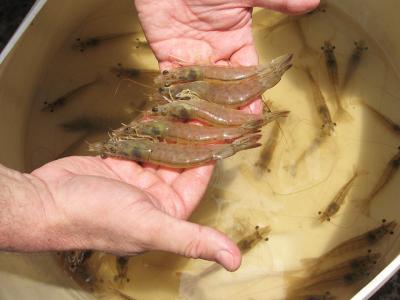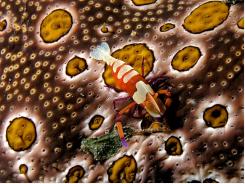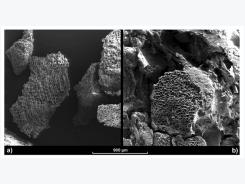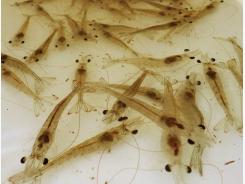Non-invasive diagnostic tool developed for shrimp disease EMS

Novel procedure can detect Acute Hepatopancreatic Necrosis Disease in penaeid shrimp
AHPND is a major global disease of farmed shrimp that has seriously affected the industry throughout many countries in Asia and Latin America. Photo by Darryl Jory.
Acute hepatopancreatic necrosis disease (AHPND) has caused substantial mortality in penaeid shrimp cultured in various countries in Southeast Asia and Latin America. The disease causes sloughing and necrosis of hepatopancreas tissue that results from toxins (pirA&Bvp) produced by specific strains of Vibrio parahaemolyticus.
Diagnosis of AHPND usually involves sacrificing the shrimp to collect hepatopancreas tissue for PCR analysis and/or histopathology. However, this invasive method is obviously not desirable for monitoring valuable broodstock, and non-sacrificial methods would be preferred. Non-invasive methods involving fecal testing have been successfully used for monitoring other enteric pathogens of shrimp.
As AHPND-bacteria are present in the digestive systems of infected shrimp, we based our research on the possibility that fecal samples could be collected for monitoring shrimp populations without causing mortalities. Here we report on our study (summarized from the original publication in Aquaculture Reports 5 (2017 58–61), where we evaluated procedures with shrimp fecal samples directly or with the enrichment of the bacteria present in the feces through culturing them in media. We thank Dr. Donald Lightner (School of Animal and Comparative Biomedical Sciences, University of Arizona, Tucson, AZ, USA) for his assistance during this study.
The use of feces as diagnostic samples from asymptomatic shrimp
This trial was designed to determine if fecal samples from AHPND-affected large juvenile shrimp can be used as diagnostic specimen. Fig. 1 (below) depicts the procedures we developed during our study. Pacific white shrimp, Penaeus vannamei, (four SPF shrimp, average weight of 8.5 grams) were fed once with shrimp pellets soaked in the AHPND-V. parahaemolyticus culture (108 CFU/mL, a sub-lethal dosage). After feeding, the shrimp were rinsed with formalin-iodine to disinfect the residual AHPND-bacteria during the per os exposure, and were then transferred into four individual tanks.

Fecal strands were collected during the three-day experimental period; then DNA was extracted and followed by an AHPND PCR targeting both toxin genes, pirAvp and pirBvp. The results showed strong positive bands after the agarose gel electrophoresis. There was no mortality in these shrimp during the trail. Upon termination, the shrimp were processed for histopathological examinations and no AHPND lesions were detected. This indicates that feces can be used as diagnostic samples for monitoring large shrimp that have asymptomatic, low levels of infection.
PCR sensitivity comparisons of templates prepared from fecal DNA or from enriched bacterial culture
SPF P. vannamei (80 shrimp, average weight: 0.7 g) were used in two immersion bioassays, 1- and 6-hour immersion with AHPND-V. parahaemolyticus broth. The fecal samples were collected after 24 hours from each bioassay. One part of the fecal samples was extracted for DNA and used directly for PCR analyses, and one part of the feces samples was cultured with TSB+ media (at a ratio of 1:1000) and incubated at 28 to 29 degrees-C for 6 hours; this broth was then used as a PCR template without DNA extraction.
With the 1-hour immersion, shrimp became moribund at day 4, with a cumulative mortality of 45 percent at termination (day 6). Twelve fecal samples were sampled and analyzed, by PCR: seven samples from the extracted DNAs had strong positive PCR results, four were weak positive and one sample was not detected. With the 6-hour immersion, shrimp became moribund at day 1 and all the shrimp died by day 2. Strong PCR amplifications were observed in both fecal DNA extract and enriched bacterial culture.
From both bioassays, we found that the enrichment method had stronger PCR band intensities than fecal DNA samples (Fig. 2), as the enrichment greatly increased the bacterial populations. The increased sensitivity from enrichment method can circumvent the use of nested PCR for AHPND detection.


Fig. 2: Because the enrichment procedure greatly increased the bacterial populations, we found it had stronger PCR band intensities than fecal DNA samples.
Perspectives
Our study showed that not all infected shrimp succumb to the AHPND disease. Likewise, in shrimp farms, animals infected with sub-lethal doses might recover from disease and become asymptomatic carriers. The diagnosis, screening, and monitoring of AHPND typically involves sacrificing individuals to obtain hepatopancreas tissue samples, a procedure that is undesirable for use with high-value broodstock.
The diagnostic test we developed and describe here for AHPND does not require sacrificing shrimp, especially for those asymptomatic survivors of valuable broodstock populations. The test involves PCR analysis of an enriched broth culture of bacteria from fecal samples. An enriched broth can be used to detect AHPND-V. parahaemolyticus in feces from both moribund and asymptomatic animals.
These findings are of interest to shrimp producers regarding the development of strategies for disease management of this serious disease AHPND, and will prove very useful in the diagnosis and monitoring of AHPND in farmed shrimp populations.
Authors
JEE EUN HAN, D.V.M. PH.D.
*Corresponding author
CJ CheilJedang Feed & Livestock Research Institute, Korea
School of Animal and Comparative Biomedical Sciences
University of Arizona
PATHARAPOL PIAMSOMBOON, D.V.M. PH.D.
Veterinary Science
Prince of Songkhla University
Songkhla, Thailand
KATHY F.J. TANG, PH.D.
School of Animal and Comparative Biomedical Sciences
University of Arizona
Tucson, AZ 85721 USA
Related news
Tools

Phối trộn thức ăn chăn nuôi

Pha dung dịch thủy canh

Định mức cho tôm ăn

Phối trộn phân bón NPK

Xác định tỷ lệ tôm sống

Chuyển đổi đơn vị phân bón

Xác định công suất sục khí

Chuyển đổi đơn vị tôm

Tính diện tích nhà kính

Tính thể tích ao




 ‘New’ disease has Indian shrimp farmers mulling return…
‘New’ disease has Indian shrimp farmers mulling return…  Effect of dietary methionine on Pacific white shrimp…
Effect of dietary methionine on Pacific white shrimp…